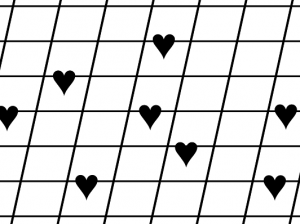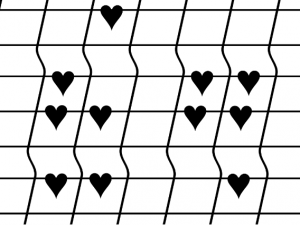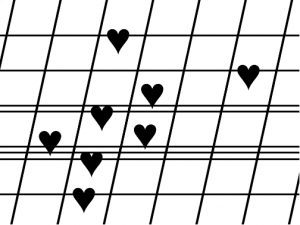By Ivan Netkachev & Roman Solodkov
Interinterface is a procedural essay on the ways that dating apps constrain and normalize queer identities of their users. By procedural essay we mean an interactive cybertext with some elements of a 3D exploration game: you can travel through it, interact with the environment, read the textual elements and end up with your own choreography of reading. The present text is an accompanying essay for the Interinterface, in which we elaborate on theoretical motivations behind our artwork, as well as present some case studies of real dating apps. (Don’t let the word “accompanying” confuse you: we think of this text as an organic part of Interinterface, since we do not set any boundaries between texts written in natural language and the ones the language of which is code.)
Interinterface is available at itch.io. An early version of it was completed by the beginning of 2023 with support from Goethe-Institut. We’ve been updating it since, and plan to add more scenes in 2024. Stay tuned.
a promo video of Interinterface
Tinder Will Find a Way with You, or How You Are Fed to AI

A schema of a latent affective space №1
In information societies, nearly every aspect of our everyday life is turned into information and then into a commodity.[i] Digital capitalism creeps into every realm of our everyday experience with the sole exception of sleep, according to the media theorist Jonathan Crary.[ii] Countless affective services promise us to make our emotional lives easier or to fulfil the emotional needs that we failed to fulfil by ourselves.
Dating apps seem to be the best-known (and the most widespread) affective services. They automatize not only our emotions but also the sociality itself: AI algorithms curate our (dis)connections with others, as well as the romantic feelings associated with them. Once a user connects to a dating app, algorithms start analyzing their behavioural data. AI relies upon a set of universalist (and essentially dehumanizing) assumptions, under which a certain pattern of user behaviour is associated with certain emotions and intentions across all humans. Combined with the data in users’ profiles — photos, age, gender, “green flags”, “red flags” and other preferences — this information is enough for AI to optimize user experience so that it is the most profitable for the developers.
Tinder — perhaps the biggest dating app for both straight and queer people — is essentially a massive online game whose rules are not fully clear to anyone except its developers. Users are faced with each other’s profiles, one at a time, and can either like or dislike someone (“swipe right” or “swipe left”). If feelings are mutual, a match occurs, which allows users to chat. This mechanic seems fairly simple: no trickery, right? We need to add a little detail, however: money can buy you some extra access rights. The basic layer of the premium subscription allows you to access the profiles of people who liked you already, without the need to go through their profiles one by one; the most expensive layer would grant you the right to text other users right away.
The game would be fair if anyone could access anyone’s profile, which is not the case in Tinder. Behind the simplistic and friendly interface of the app a hidden machinery decides who sees who. For Tinder algorithms, dating has much in common with a zero-sum game such as chess: you win if someone likes you and you lose if someone rejects you; a match is a draw. Based on how often you “win” or “lose”, you acquire a rating — your personal desirability score.
It seems that the score is not calculated solely from your personal ratio of likes and dislikes: other kinds of data are also fed to the algorithm defining it, according to some insiders from the company. The mechanics of Tinder remain opaque to the users — which is generally characteristic of proprietary software using AI.[iii] The only way to understand the logic behind Tinder is to reverse-engineer it, as some researchers have done already.[iv] And yet the fact that the users are scored on a universal scale of “desirability” is problematic in itself. You may not be a lookist, but the AI behind Tinder is; that we’re told that there are no universally attractive features, but Tinder thinks otherwise.
“Desirable” users get to see other “desirable” users; “not-so-attractive” ones are limited to other “not-so-attractive” ones. They say that those restrictions serve to connect similar people; but, in reality, what we have here is indeed another filter bubble — we’d call it an affective filter bubble.[v] Developers claim that it serves to improve user experience, but the real goal is the maximization of profit. Tinder feels how popular you are; moreover, by analyzing your swipe patterns and other behavioural data, it predicts how much you need a relationship. Are you feeling lonely, or perhaps you’re just horny and want a quick hook-up? AI will detect your compulsive swipe patterns and use this information against you.
To give you an extreme example: a 2020 investigation showed that straight middle-aged men are charged for the premium subscription five times more than queer females under 30. The explanation is simple: older men face more struggles in finding a potential partner, and, at the same time, they are statistically more solvent than younger people. Tinder algorithms, then, manipulate them into buying the premium subscription and charging them more than others.
Tinder’s personalization algorithms will find a way with everyone. If you’re not a 30+ straight man, it does not necessarily make dating easier for you; you’ll still get your personalized pricing for the premium, and the application will push you into buying it.
Axes of Self-Reduction, or Disciplinary Power of Interfaces

A schema of a latent affective space №2
So, in dating apps, users’ identities are being digitized, compressed and reduced to a few numeric parameters, and this traumatic reduction occurs in several stages. Once one enters a dating app, they are reduced to a vector in a multi-dimensional space, thus becoming a perfect target for machine learning. Then another reduction occurs: a vector, or a data point, is transformed into a single parameter. Sorry, but you’re only 60% attractive today. Change your profile pic and swipe patterns, and perhaps the app will reconsider (or it won’t).
There is yet another reduction of the Self in dating apps: it occurs even before those two, and we ourselves perform it on ourselves. To create a dating profile, a user has to complete a questionnaire: name, gender, sexual preferences, photos… The profile is thus no less bureaucratic than, say, a passport — and bureaucracy subsumes a grand amount of hidden bureaucratic violence, as the anthropologist David Graeber has shown.[vi] The language of bureaucracy is essentially a dead language, and representing one’s identity as a set of parameters means enclosing the Self into the dead structures of collective imagination.
Another axis of self-reduction hides in the predominantly visual modality of dating apps. Their design pushes users into making quick decisions, and those decisions are based mainly on visual information: it’s much quicker to see than to read. Descriptions are secondary even at the level of interfaces: one is not required to take an extra step and open the full bio of a person to like them or dislike.
“Visuality turns the body into a commodity – a consumable object shaped by a consumer logic”, writes the sociologist Eva Ellouz in her recent paper on online dating.[vii] Users create fragmented visual representations of their bodies, which then become commodities circulating on a scopic market. Dating apps are indeed scopic markets, writes Illouz, where the value is created “through the valuation of images of sexual bodies destined to be consumed by the gaze.”
Finally, yet another axis of reduction of the Self lies in the realm of decision-making. As Illouz reminds us, dating apps not only push users into making quick decisions — they also constrain them to make a binary choice. It’s either yes or no, swipe left or swipe right. “This binary emotional logic seems much closer to the workings of a computer processor”, as Illouz puts it.
Reduced to a vector along those axes of reduction, queer identity becomes essentially disassembled. Our bodies are not made out of images and textual data, and our emotional lives cannot be reduced to a binary logic. We would go as far as to claim that the Self in its essence shares some core features of queerness, being fluid, elusive and never equal to itself. The Self unfolds itself in a processual manner, which is, according to the architect Christopher Alexander, characteristic of any living structures in general,[viii] while digital interfaces are standardized and homogenizing.
Dating apps transform the Self into an exquisite corpse: a ghostly surrealist entity stuck between life and death, human and non-human.[ix] Or, put differently: we deliberately become surrealist compulsive subjects: disintegrated and fragmented. Surrealist compulsive writing as an artistic strategy gives way to compulsive swiping.
Interface as a Non-Place, or Hidden Devices of Homogenization and Normalization

A schema of a latent affective space №3
This machinery of Self-reduction is hidden from users’ eyes by digital interfaces. According to the philosopher Alexander Galloway, interfaces trick us by hiding their presence.[x] The more comfortable and “user friendly” an interface is, the more it seeks to erase its presence: if it is intuitive enough, we feel immersed in a digital space. Once comfortable with an app, we develop a kinetic habit: this action causes that effect as if this causality was a law of nature.
And yet the interface is by no means “natural”, nor is it a window to another world. On the contrary, it creates user experience from scratch. Interfaces have much in common with ideologies: they maintain their own imaginary causality.[xi] The power of an ideology consists in that we do not question its authority; we just act as if a set of ideological assumptions was part of the real. In other words, ideologies are not believed in — they are enacted. In a similar fashion, interfaces define the whole logic of interaction with an app.
Digital interfaces are thresholds, or filters, performing manipulations on data. At the same time, they pretend to be a window: subtle, transparent and showing the truth. And yet this is only an appearance: interfaces are indeed spatial structures with complex architectures, which is also true of dating interfaces.
We suggest, thus, that to criticize an interface is to uncover spatial machinery behind it. Once one adopts this spatial metaphor, it becomes clear that interfaces are essentially non-places: anonymous and transit spaces.[xii] In a non-place, the flow of time slows down — to the point where both subjective and historical times nearly vanish. Digital thresholds homogenize users’ personal flows of time; and machinic times gives rise to standardized machinic subjectivity. Solidarity through the creation of a common narrative is impossible in such a place, and is replaced by connectivity.
A dating interface is not a place where people meet each other as they are. It’s a place where their subjectivities are normalized and homogenized to the point where they are deemed “compatible” by the algorithms. The axes of Self-reduction that we described earlier require a complex spatial architecture: those are inter-connected machines in a factory where our new, machinic subjectivities are being produced.
***
Let us sum it up: affective interfaces are not transparent windows leading to the Other — in reality, they are nothing but factories with complex internal architectures. The next step of the deconstruction of affective interfaces is a detailed documentation of the relations between the machines in such a factory. But it’s here that we would like the present essay to end — and the procedural essay Interinterface to begin. You may find it on a dedicated page on itch.io.
As for now, you may find yourself inside the black box AI and to witness the way your subjectivity is being transformed into a “desirability score”. Furthermore, you may try to assemble a body dismembered by questionnaires and algorithms — and eventually fail to do that. Stay tuned, since we plan to add more scenes (or machines) shortly.
—
Ivan Netkachev (b. 1998, Orenburg, Russia) is a multimedia artist, researcher, and writer. He works with generative poetry, automatic generation of texts and images, video games, and video. In his artistic practice, he attempts at discovering the hidden politics behind the AI, whose algorithms structure and constrain users’ emotions and, more broadly, the common unconscious. Currently based in Tbilisi, Georgia.
Roma Solodkov (b. 1995) is a Moscow-born artist and educator currently based in Bangkok. He comes from a background in biology and neuroscience, and his artistic practice is partially informed by the positivist thought-systems and an impulse to deconstruct them. Roma works with a wide range of digital media (3D-graphics/animation, game engines, real-time generative systems) and interactive phygital installations, searching for alternative forms of agency, access and embodiment in our interaction with the digital, algorithmic and the abstract.
—
Endnotes
[i] MсKenzie Wark, A Hacker Manifesto. Harvard University Press, 2004. See also: Wark, McKenzie. Capital is dead: Is this something worse?. Verso books, 2021.
[ii] Jonathan Crary, 24/7: Late capitalism and the ends of sleep. Verso Books, 2013.
[iii] Madalina Busuioc, ‘Accountable artificial intelligence: Holding algorithms to account’, Public Administration Review 81.5 (2021): 825-836.
[iv] Lene Pettersen and Runar Døving, ‘The construction of matches in dating platforms’, Nordic Journal of Science and Technology Studies 11.1 (2023).
[v] On filter bubbles, see: Lorenza Parisi and Francesca Comunello, “Dating in the time of “relational filter bubbles”: Exploring imaginaries, perceptions and tactics of Italian dating app users.” The Communication Review 23.1 (2020): 66-89.
[vi] David Graeber, The utopia of rules: On technology, stupidity, and the secret joys of bureaucracy. Melville House, 2015.
[vii] Eva Illouz and Dan M. Kotliar. ‘Capitalist Subjectivity, Tinder, and the Emotionalization of the Web’, in Rosa Llamaas and Russell Belk (eds) The Routledge Handbook of Digital Consumption, Taylor & Francis, 2022. See also: Illouz, Eva. Cold intimacies: The making of emotional capitalism. Polity, 2007.
[viii] Christopher Alexander, The Nature of Order: An Essay on the Art of Building and The Nature of the Universe: The Process of Creating Life. The Center for Environmental Structure, 2004.
[ix] Katharine Conley, ‘Surrealism’s Ghostly Automatic Body’, Contemporary French and Francophone Studies 15.3 (2011): 297-304.
[x] Alexander R. Galloway, The interface effect. Polity, 2012.
[xi] Wendy Hui Kyong Chun, ‘On software, or the persistence of visual knowledge’, grey room (2005): 26-51.
[xii] Marc Augé, Non-places: An introduction to supermodernity. Verso Books, 2020.

